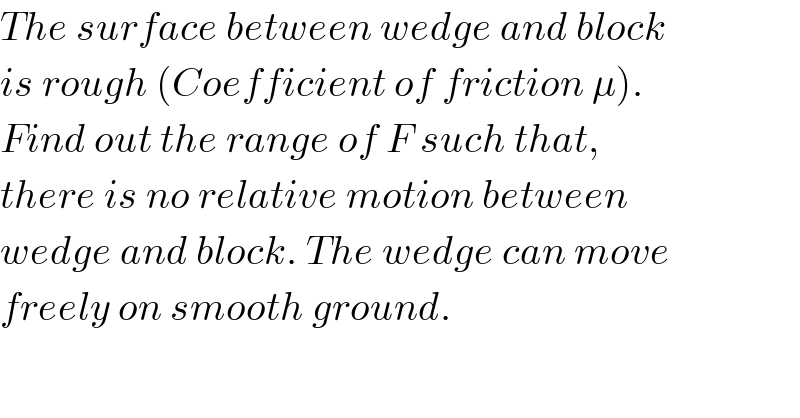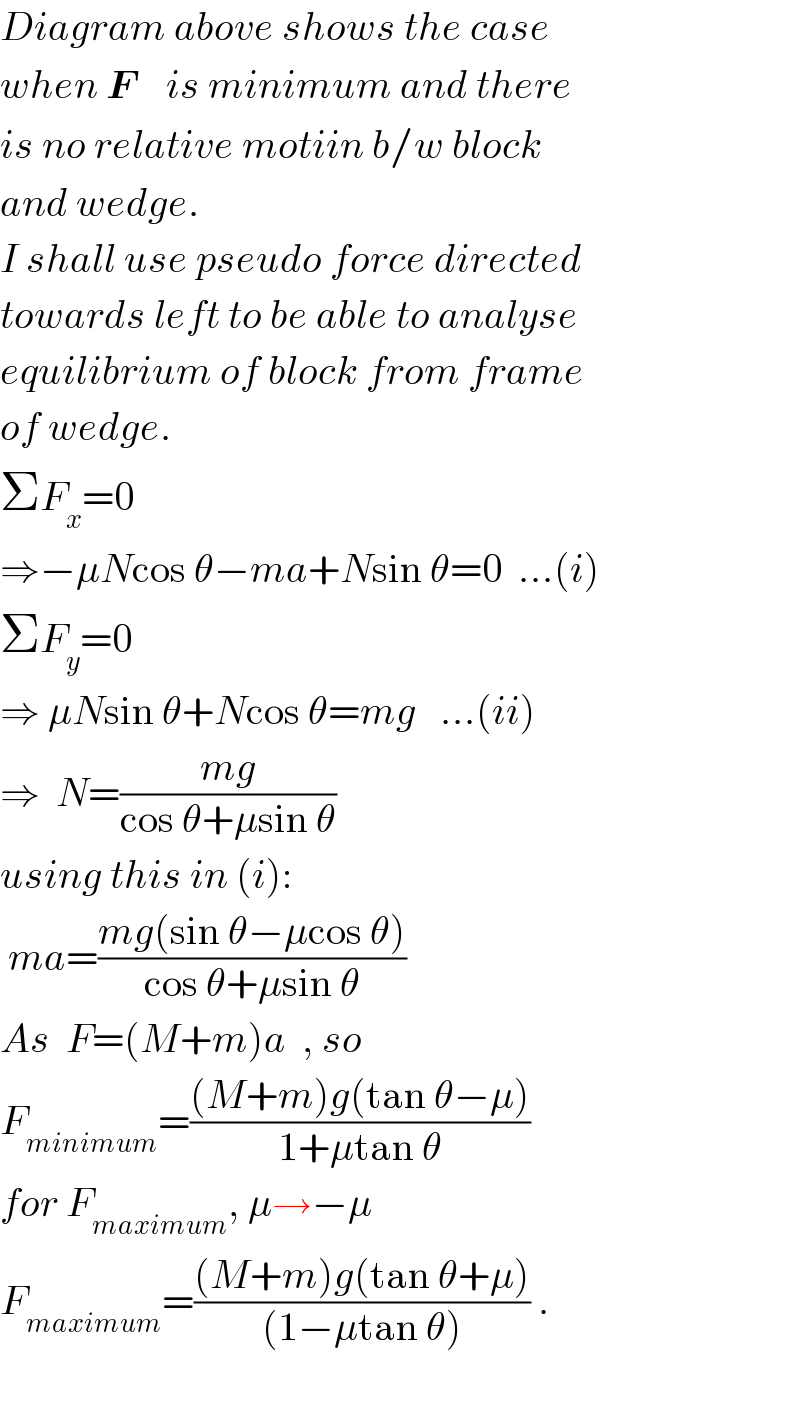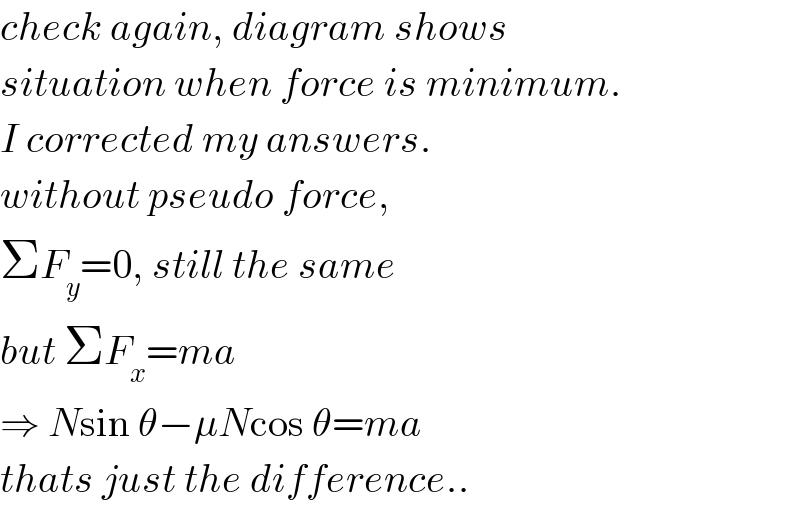
Question Number 20581 by Tinkutara last updated on 28/Aug/17

$${The}\:{surface}\:{between}\:{wedge}\:{and}\:{block} \\ $$$${is}\:{rough}\:\left({Coefficient}\:{of}\:{friction}\:\mu\right). \\ $$$${Find}\:{out}\:{the}\:{range}\:{of}\:{F}\:{such}\:{that}, \\ $$$${there}\:{is}\:{no}\:{relative}\:{motion}\:{between} \\ $$$${wedge}\:{and}\:{block}.\:{The}\:{wedge}\:{can}\:{move} \\ $$$${freely}\:{on}\:{smooth}\:{ground}. \\ $$
Commented by Tinkutara last updated on 28/Aug/17

Commented by ajfour last updated on 28/Aug/17

Commented by ajfour last updated on 28/Aug/17

$${Diagram}\:{above}\:{shows}\:{the}\:{case} \\ $$$${when}\:\boldsymbol{{F}}\:\:\:\:{is}\:{minimum}\:{and}\:{there} \\ $$$${is}\:{no}\:{relative}\:{motiin}\:{b}/{w}\:{block} \\ $$$${and}\:{wedge}. \\ $$$${I}\:{shall}\:{use}\:{pseudo}\:{force}\:{directed} \\ $$$${towards}\:{left}\:{to}\:{be}\:{able}\:{to}\:{analyse} \\ $$$${equilibrium}\:{of}\:{block}\:{from}\:{frame} \\ $$$${of}\:{wedge}. \\ $$$$\Sigma{F}_{{x}} =\mathrm{0}\:\: \\ $$$$\Rightarrow−\mu{N}\mathrm{cos}\:\theta−{ma}+{N}\mathrm{sin}\:\theta=\mathrm{0}\:\:...\left({i}\right) \\ $$$$\Sigma{F}_{{y}} =\mathrm{0} \\ $$$$\Rightarrow\:\mu{N}\mathrm{sin}\:\theta+{N}\mathrm{cos}\:\theta={mg}\:\:\:...\left({ii}\right) \\ $$$$\Rightarrow\:\:{N}=\frac{{mg}}{\mathrm{cos}\:\theta+\mu\mathrm{sin}\:\theta} \\ $$$${using}\:{this}\:{in}\:\left({i}\right): \\ $$$$\:{ma}=\frac{{mg}\left(\mathrm{sin}\:\theta−\mu\mathrm{cos}\:\theta\right)}{\mathrm{cos}\:\theta+\mu\mathrm{sin}\:\theta} \\ $$$${As}\:\:{F}=\left({M}+{m}\right){a}\:\:,\:{so} \\ $$$${F}_{{minimum}} =\frac{\left({M}+{m}\right){g}\left(\mathrm{tan}\:\theta−\mu\right)}{\mathrm{1}+\mu\mathrm{tan}\:\theta} \\ $$$${for}\:{F}_{{maximum}} ,\:\mu\rightarrow−\mu \\ $$$${F}_{{maximum}} =\frac{\left({M}+{m}\right){g}\left(\mathrm{tan}\:\theta+\mu\right)}{\left(\mathrm{1}−\mu\mathrm{tan}\:\theta\right)}\:. \\ $$$$ \\ $$
Commented by Tinkutara last updated on 28/Aug/17

$$\mathrm{Thank}\:\mathrm{you}\:\mathrm{very}\:\mathrm{much}\:\mathrm{Sir}!\:\mathrm{But}\:\mathrm{can}\:\mathrm{it}\:\mathrm{be} \\ $$$$\mathrm{solved}\:\mathrm{without}\:\mathrm{using}\:\mathrm{pseudo}\:\mathrm{force}? \\ $$
Commented by ajfour last updated on 28/Aug/17

$${check}\:{again},\:{diagram}\:{shows} \\ $$$${situation}\:{when}\:{force}\:{is}\:{minimum}. \\ $$$${I}\:{corrected}\:{my}\:{answers}. \\ $$$${without}\:{pseudo}\:{force}, \\ $$$$\Sigma{F}_{{y}} =\mathrm{0},\:{still}\:{the}\:{same} \\ $$$${but}\:\Sigma{F}_{{x}} ={ma} \\ $$$$\Rightarrow\:{N}\mathrm{sin}\:\theta−\mu{N}\mathrm{cos}\:\theta={ma} \\ $$$${thats}\:{just}\:{the}\:{difference}.. \\ $$
